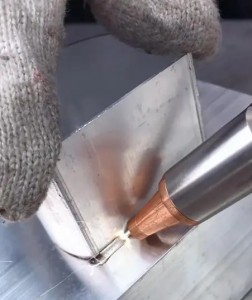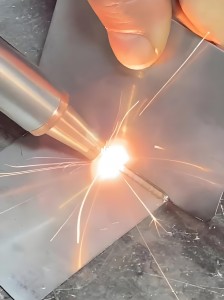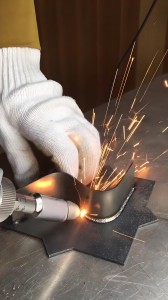In the modern industrial field, the handheld welding machine has become an indispensable tool due to its flexibility and convenience. And to fully exert the advantages of the handheld welding machine, correctly adjusting the focal length is the key among the keys. The following will elaborate in detail how to adjust the focal length of the handheld welding machine and the key points therein.
For example, in an auto parts manufacturing plant, workers used a handheld welding machine to weld thin steel plates. At first, due to improper focal length setting, there were obvious thermal deformations and unevenness at the welded joints. Later, the workers carefully analyzed the thickness of the steel plate, appropriately shortened the focal length, and after welding again, the weld seam became uniform and firm, which nicely solved the problem.
One of the key points is to clearly understand the nature of the welding material. Different materials, whether it is the type of metal, the thickness, or the surface condition, will all have an impact on the focal length. For example, for thinner metal sheets, a shorter focal length is required to concentrate the energy to avoid excessive penetration or thermal deformation; while for thicker workpieces, the focal length needs to be correspondingly increased to ensure the welding depth and strength.
Environmental factors are also key points that cannot be ignored. In a metal structural parts processing workshop, due to the strong on-site light, it interfered with the adjustment of the focal length, resulting in poor welding results initially. Later, it was adjusted to an area with relatively soft light for operation, and only then the desired welding effect was obtained.
In the actual debugging process, operators can follow these steps. First, roughly set a focal length range, and then turn on the welding machine for a preliminary attempt. Observe the size, shape, and brightness of the welding spot. If the welding spot is too large or too blurred, it indicates that the focal length may not be accurate and needs to be gradually fine-tuned. At the same time, pay attention to observing the formation of the weld seam during the welding process, such as the width and uniformity of the weld seam. Just like when welding a workpiece with a complex shape once, the workers continuously fine-tuned the focal length by observing the changes of the weld seam, and finally found the most appropriate focal length to ensure the welding quality of the entire workpiece.
In addition, the experience and skills of the operator are also crucial. Experienced welders can rely on intuitive feelings and long-term accumulated experience to find the appropriate focal length more quickly and accurately. They can keenly perceive the subtle changes in the welding process and make corresponding adjustments in time.
In order to ensure the accuracy and stability of adjusting the focal length, regular maintenance and calibration of the welding machine are also necessary. Check whether the lens is clean, whether the optical path is unobstructed, and whether each component is working properly, etc.
In addition, some auxiliary tools and techniques can also be used to improve the efficiency and accuracy of adjusting the focal length. For example, using a laser pointer to assist in determining the approximate range of the focal length, or using advanced welding monitoring equipment to monitor the parameter changes in the welding process in real-time, thereby providing a more scientific basis for focal length adjustment.
In conclusion, adjusting the focal length of a handheld welding machine is a comprehensive task that requires comprehensive consideration of multiple key points such as the nature of the material, environmental factors, operator experience, and equipment maintenance. Only by achieving all aspects can the handheld welding machine exert its best welding effect and provide a strong guarantee for high-quality and high-efficiency industrial production. We look forward to continuous improvement and innovation in the technology of focal length adjustment of handheld welding machines in continuous practice and exploration, bringing more innovation and development opportunities to the industrial field.

In the modern industrial field, the handheld welding machine has become an indispensable tool due to its flexibility and convenience. And to fully exert the advantages of the handheld welding machine, correctly adjusting the focal length is the key among the keys. The following will elaborate in detail how to adjust the focal length of the handheld welding machine and the key points therein.
For example, in an auto parts manufacturing plant, workers used a handheld welding machine to weld thin steel plates. At first, due to improper focal length setting, there were obvious thermal deformations and unevenness at the welded joints. Later, the workers carefully analyzed the thickness of the steel plate, appropriately shortened the focal length, and after welding again, the weld seam became uniform and firm, which nicely solved the problem.
One of the key points is to clearly understand the nature of the welding material. Different materials, whether it is the type of metal, the thickness, or the surface condition, will all have an impact on the focal length. For example, for thinner metal sheets, a shorter focal length is required to concentrate the energy to avoid excessive penetration or thermal deformation; while for thicker workpieces, the focal length needs to be correspondingly increased to ensure the welding depth and strength.
Environmental factors are also key points that cannot be ignored. In a metal structural parts processing workshop, due to the strong on-site light, it interfered with the adjustment of the focal length, resulting in poor welding results initially. Later, it was adjusted to an area with relatively soft light for operation, and only then the desired welding effect was obtained.
In the actual debugging process, operators can follow these steps. First, roughly set a focal length range, and then turn on the welding machine for a preliminary attempt. Observe the size, shape, and brightness of the welding spot. If the welding spot is too large or too blurred, it indicates that the focal length may not be accurate and needs to be gradually fine-tuned. At the same time, pay attention to observing the formation of the weld seam during the welding process, such as the width and uniformity of the weld seam. Just like when welding a workpiece with a complex shape once, the workers continuously fine-tuned the focal length by observing the changes of the weld seam, and finally found the most appropriate focal length to ensure the welding quality of the entire workpiece.
In addition, the experience and skills of the operator are also crucial. Experienced welders can rely on intuitive feelings and long-term accumulated experience to find the appropriate focal length more quickly and accurately. They can keenly perceive the subtle changes in the welding process and make corresponding adjustments in time.
In order to ensure the accuracy and stability of adjusting the focal length, regular maintenance and calibration of the welding machine are also necessary. Check whether the lens is clean, whether the optical path is unobstructed, and whether each component is working properly, etc.
In addition, some auxiliary tools and techniques can also be used to improve the efficiency and accuracy of adjusting the focal length. For example, using a laser pointer to assist in determining the approximate range of the focal length, or using advanced welding monitoring equipment to monitor the parameter changes in the welding process in real-time, thereby providing a more scientific basis for focal length adjustment.
In conclusion, adjusting the focal length of a handheld welding machine is a comprehensive task that requires comprehensive consideration of multiple key points such as the nature of the material, environmental factors, operator experience, and equipment maintenance. Only by achieving all aspects can the handheld welding machine exert its best welding effect and provide a strong guarantee for high-quality and high-efficiency industrial production. We look forward to continuous improvement and innovation in the technology of focal length adjustment of handheld welding machines in continuous practice and exploration, bringing more innovation and development opportunities to the industrial field.


Post time: Jun-17-2024


